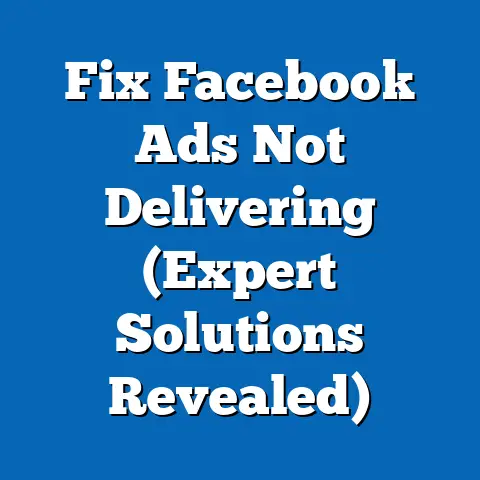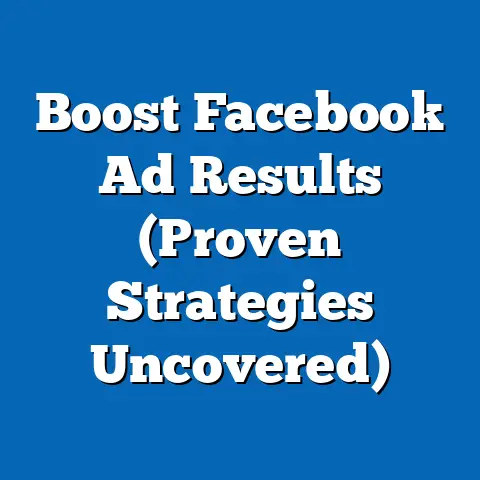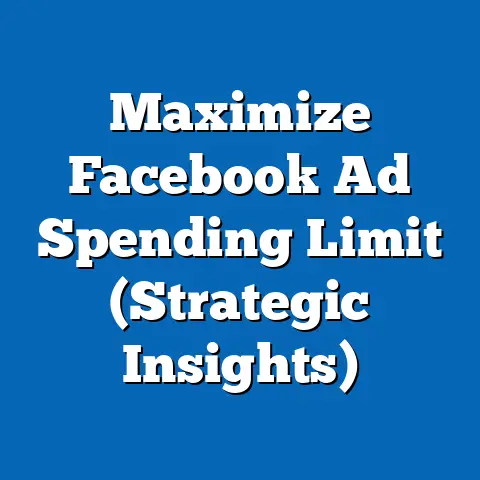Mastering Facebook Ads Audit (Proven Strategies)
Facebook advertising is a powerhouse for businesses today. As of 2023, Facebook’s ad revenue accounted for 97% of the company’s total revenue. Think about that – almost the entire revenue stream is fueled by ads! This massive reliance underscores just how critical Facebook is for digital marketing. But here’s the thing: simply throwing money at Facebook ads isn’t a guaranteed recipe for success. In today’s competitive landscape, you need to be smart, strategic, and constantly optimizing your campaigns. That’s where a Facebook Ads audit comes in.
I’ve seen firsthand how a well-executed audit can transform struggling campaigns into high-performing assets. It’s not just about checking boxes; it’s about digging deep, understanding the data, and making informed decisions that drive real results. In this guide, I’ll walk you through the essential steps to master the art of the Facebook Ads audit, ensuring you’re getting the most bang for your buck and achieving your business goals.
What is a Facebook Ads Audit and Why Does it Matter?
A Facebook Ads audit is a comprehensive review of your entire Facebook advertising ecosystem. It’s about taking a step back and critically examining every aspect of your campaigns, from your objectives and targeting to your ad creative and budget allocation.
The purpose of this audit is threefold:
- Identify Strengths and Weaknesses: Figure out what’s working well and where your campaigns are falling short.
- Assess Budget Allocation: Ensure your budget is being spent efficiently and effectively across different campaigns and ad sets.
- Optimize Targeting: Refine your audience targeting to reach the most relevant and engaged users.
The frequency of your audits will depend on several factors, including your ad spend, the duration of your campaigns, and your overall business objectives. As a general rule, I recommend conducting a thorough audit at least once a quarter, or even more frequently if you’re running large-scale campaigns or experiencing significant performance fluctuations. Think of it as a regular health check for your advertising strategy.
Key Components of a Facebook Ads Audit
A successful Facebook Ads audit involves a deep dive into several key areas. Let’s break down each component and explore what to look for:
1. Ad Objectives: Are You Aiming at the Right Target?
The first step is to examine your ad objectives. Are you truly using the right objective for what you’re trying to achieve? I’ve often seen businesses select the wrong objective, leading to suboptimal results.
Why it matters: Selecting the wrong objective can significantly impact how Facebook optimizes your ads. For example, if you’re aiming for conversions but choose the “Traffic” objective, Facebook will prioritize showing your ads to users who are likely to click, not necessarily those who are likely to convert.
What to look for:
- Alignment with Business Goals: Ensure your ad objectives directly support your overall business goals. Are you trying to generate leads, drive sales, increase brand awareness, or something else?
- Appropriate Objective Selection: Verify that you’ve chosen the most appropriate objective for each campaign. Consider whether you should be using “Conversions,” “Lead Generation,” “Brand Awareness,” or another objective.
Example: I once worked with a client who was running a campaign to generate leads for their software product. They had chosen the “Traffic” objective, hoping to drive more people to their landing page. However, after switching to the “Lead Generation” objective and using Facebook’s built-in lead forms, we saw a dramatic increase in the number of qualified leads at a lower cost.
2. Target Audience: Are You Reaching the Right People?
Your target audience is the lifeblood of your Facebook ads. If you’re not reaching the right people, your ads will fall flat, no matter how compelling your creative is.
Why it matters: Precise targeting ensures that your ads are shown to users who are most likely to be interested in your product or service. This leads to higher engagement, better conversion rates, and a lower cost per acquisition.
What to look for:
- Demographics: Review your demographic targeting settings, including age, gender, location, and language. Are you targeting the right age group, gender, and geographic area for your product or service?
- Interests: Examine your interest-based targeting. Are you targeting relevant interests and hobbies? Consider using broad and narrow targeting to test different audiences.
- Behaviors: Leverage Facebook’s behavioral targeting options, such as purchase behaviors, device usage, and travel habits. This can help you reach users who are more likely to take a specific action.
- Custom Audiences: Analyze your custom audiences, including website visitors, email lists, and app users. Are you effectively retargeting these valuable audiences?
- Lookalike Audiences: Evaluate the performance of your lookalike audiences. Are they accurately mirroring your source audiences? Consider testing different lookalike percentages.
Example: I worked with an e-commerce store that was targeting a broad audience with their ads. After analyzing their customer data and creating a lookalike audience based on their best customers, we saw a significant improvement in their conversion rates and a reduction in their cost per purchase.
3. Ad Creative: Is Your Message Resonating?
Your ad creative is what grabs users’ attention and persuades them to take action. It includes your ad copy, images, videos, and overall design.
Why it matters: Compelling ad creative is essential for capturing attention in a crowded news feed and driving engagement. It’s the first impression you make on potential customers.
What to look for:
- Ad Copy: Review your ad copy for clarity, conciseness, and relevance. Does it clearly communicate your value proposition? Does it speak to your target audience’s needs and pain points?
- Visuals: Evaluate the quality and relevance of your images and videos. Are they visually appealing? Do they accurately represent your brand and product?
- A/B Testing: Implement A/B testing to compare different ad creatives and identify the most effective variations. Test different headlines, body copy, images, and calls to action.
- Relevance: Ensure your ad creative is relevant to your target audience and the platform on which it’s being displayed. Tailor your creative for different placements (e.g., News Feed, Stories, Instagram).
Example: I worked with a restaurant that was running the same ad creative across all placements. After tailoring their ad creative for different platforms (e.g., using shorter videos for Stories and more visually appealing images for Instagram), we saw a significant increase in engagement and reservations.
4. Ad Placement: Are You in the Right Neighborhood?
Ad placement refers to where your ads are displayed on Facebook, Instagram, and the Audience Network.
Why it matters: Different placements have different audiences and engagement levels. Choosing the right placements can significantly impact your ad performance.
What to look for:
- Placement Performance: Analyze the performance of different placements, such as News Feed, Stories, Instagram Feed, and Audience Network. Which placements are driving the most conversions at the lowest cost?
- Placement Optimization: Optimize your ad placements based on your performance data. Consider excluding placements that are underperforming.
- Platform-Specific Creative: Tailor your ad creative for different placements. Use shorter videos for Stories and more visually appealing images for Instagram.
Example: I worked with an online retailer that was automatically placing their ads across all available placements. After analyzing their data, we discovered that their ads were performing poorly on the Audience Network. By excluding the Audience Network, we were able to significantly improve their overall ad performance.
5. Budget and Bidding: Are You Spending Wisely?
Your budget and bidding strategy determine how much you’re spending on your ads and how Facebook is optimizing your bids.
Why it matters: Effective budget management and bidding strategies are crucial for maximizing your ROI and achieving your advertising goals.
What to look for:
- Budget Allocation: Review your budget allocation across different campaigns and ad sets. Are you allocating enough budget to your top-performing campaigns?
- Bidding Strategy: Evaluate your bidding strategy. Are you using the right bidding strategy for your objectives? Consider using automated bidding strategies like “Lowest Cost” or “Cost Cap” to optimize your bids.
- Ad Spend Efficiency: Analyze your ad spend efficiency. Are you getting the most conversions at the lowest cost? Identify areas where you can reduce your ad spend without sacrificing performance.
Example: I worked with a startup that was running a limited budget for their Facebook ads. After analyzing their data, we discovered that they were overspending on certain keywords and placements. By optimizing their bidding strategy and budget allocation, we were able to significantly improve their ROI and generate more leads with the same budget.
Proven Strategies for Conducting an Effective Audit
Now that you understand the key components of a Facebook Ads audit, let’s dive into some proven strategies for conducting an effective audit:
1. Utilize Facebook Ads Manager: Your Data Hub
Facebook Ads Manager is your primary tool for gathering data and analyzing your ad performance. It provides a wealth of information about your campaigns, ad sets, and ads.
Step-by-Step Guide:
- Log in to Facebook Ads Manager: Access Ads Manager through your Facebook business account.
- Navigate to the Campaigns Tab: Select the “Campaigns” tab to view a list of your active campaigns.
- Select a Campaign: Choose the campaign you want to audit.
- Navigate to the Ad Sets Tab: Select the “Ad Sets” tab to view a list of ad sets within the campaign.
- Select an Ad Set: Choose the ad set you want to audit.
- Navigate to the Ads Tab: Select the “Ads” tab to view a list of ads within the ad set.
- Customize Columns: Customize the columns to display the metrics you want to track, such as CTR, CPC, conversion rate, and ROAS.
- Filter and Sort Data: Filter and sort the data to identify trends and outliers.
2. Set KPIs: Measuring What Matters
Key Performance Indicators (KPIs) are the metrics you’ll use to track your ad performance and measure the success of your campaigns.
Essential KPIs to Track:
- Click-Through Rate (CTR): The percentage of users who click on your ad after seeing it. A high CTR indicates that your ad creative is resonating with your target audience.
- Cost Per Click (CPC): The amount you pay each time someone clicks on your ad. A low CPC indicates that your targeting and bidding strategies are effective.
- Conversion Rate: The percentage of users who take a desired action after clicking on your ad, such as making a purchase or filling out a form. A high conversion rate indicates that your landing page and offer are compelling.
- Return on Ad Spend (ROAS): The amount of revenue you generate for every dollar you spend on advertising. A high ROAS indicates that your campaigns are profitable.
- Cost Per Acquisition (CPA): The amount you pay to acquire a new customer. A low CPA indicates that your campaigns are efficient.
3. Competitor Analysis: Learning from the Best (and Worst)
Analyzing your competitors’ ads can provide valuable insights into what’s working in your industry and what’s not.
How to Analyze Competitor Ads:
- Identify Key Competitors: Identify your main competitors on Facebook.
- Use Facebook Ad Library: Use the Facebook Ad Library to view your competitors’ active ads.
- Analyze Ad Creative: Analyze their ad copy, images, videos, and overall design. What messages are they using? What visuals are they using?
- Identify Targeting Strategies: Try to identify their targeting strategies. Who are they targeting? What interests and behaviors are they targeting?
- Learn from Their Successes and Failures: Learn from their successes and failures. What can you apply to your own campaigns?
4. Use of Reporting Tools: Automating the Process
Several reporting tools can assist you in gathering data and generating reports for your Facebook Ads audit.
Popular Reporting Tools:
- Facebook Ads Manager Reporting: Use Facebook Ads Manager’s built-in reporting features to generate custom reports.
- Google Analytics: Integrate Google Analytics with your Facebook ads to track website conversions and user behavior.
- Third-Party Reporting Tools: Consider using third-party reporting tools like [mention specific tools] for more advanced reporting and analysis.
5. Document Findings: Creating a Roadmap for Improvement
Documenting your findings is crucial for creating a structured report that will guide your future ad strategies.
What to Include in Your Report:
- Executive Summary: A brief overview of your findings and recommendations.
- Detailed Analysis: A detailed analysis of each key component of your Facebook ads, including ad objectives, target audience, ad creative, ad placement, and budget and bidding.
- Key Insights: Key insights and observations from your analysis.
- Recommendations: Specific recommendations for improving your ad performance.
- Action Plan: A detailed action plan for implementing your recommendations.
Common Pitfalls to Avoid During an Audit
While conducting a Facebook Ads audit, it’s essential to be aware of common pitfalls that can undermine your efforts:
- Neglecting Data Analysis: Failing to thoroughly analyze the data and draw meaningful conclusions.
- Ignoring Insights: Failing to follow up on insights gained from the audit and implement necessary changes.
- Becoming Complacent: Becoming complacent with successful ads and failing to continually test and innovate.
- Overlooking External Factors: Ignoring external factors that can impact your ad performance, such as seasonality, market trends, and competitor activity.
- Failing to Update Knowledge: Not staying up-to-date with the latest Facebook advertising features and best practices.
Case Studies and Real-Life Examples
Let’s look at a few case studies to illustrate how meticulous auditing can improve ad performance:
Case Study 1: E-commerce Store
- Challenge: Low conversion rates and high cost per acquisition.
- Audit Findings: Broad targeting, irrelevant ad creative, and poor placement optimization.
- Strategies Implemented: Refined targeting based on customer data, created more compelling ad creative, and optimized placement settings.
- Results: Conversion rates increased by 50%, and cost per acquisition decreased by 30%.
Case Study 2: Lead Generation Company
- Challenge: Low lead quality and high cost per lead.
- Audit Findings: Incorrect ad objective, ineffective lead forms, and lack of retargeting.
- Strategies Implemented: Switched to the “Lead Generation” objective, optimized lead forms, and implemented retargeting campaigns.
- Results: Lead quality improved by 40%, and cost per lead decreased by 25%.
Case Study 3: Local Restaurant
- Challenge: Low brand awareness and limited foot traffic.
- Audit Findings: Generic ad creative, broad targeting, and lack of local focus.
- Strategies Implemented: Created visually appealing ad creative showcasing their menu and ambiance, targeted local residents, and offered special promotions for first-time visitors.
- Results: Brand awareness increased by 60%, and foot traffic increased by 40%.
Conclusion: Mastering the Art of the Facebook Ads Audit
Mastering the Facebook Ads audit is not just a one-time task; it’s an ongoing process that requires dedication, attention to detail, and a willingness to adapt to changing trends and best practices. By following the strategies outlined in this guide, you can gain valuable insights into your ad performance, optimize your campaigns, and achieve better results.
Remember, Facebook advertising is a dynamic landscape. What works today may not work tomorrow. That’s why it’s crucial to continually refine your approach, test new strategies, and stay ahead of the curve.
I encourage you to implement the strategies outlined in this guide and share your experiences with Facebook Ads audits. What strategies have worked best for you? What challenges have you faced? By sharing your insights, we can all learn from each other and become better Facebook advertisers.






